The Self System Drawing: Teaching a Sustainable Worldview through Creativity
Full PDF: Meachan JSE Vol 6 Dec2014
Abstract: A personal reflection, from the professors’ perspective, of an arts integrated learning tool created to teach systems concepts in college level environmental studies and sustainability courses.
Keywords: sustainability, environmental studies, art, experiential learning
The mid-February, Northeast Ohio wind presses against my classroom window, reaching icy tendrils through the cracks around the air conditioning units. The afternoon sky hangs low and dark. It seems there is no sun. A lone bird calls in a thin voice from the window ledge outside.
Inside, I stand in front of 15 perplexed students holding a giant Ziplock bag of magic markers and crayons in one hand, and 15 sheets of large drawing paper in the other. Like the bird, I am perched at the edge of a precipice of sorts, preparing to cross into new territory in my teaching. Some students snicker, others look excited, one or two roll their eyes. I can feel my stomach clench as I prepare to step across the line of what my students expect in a college classroom. This is Ecophilosophy, a class I created, which is already outside the lines of a traditional environmental philosophy class, with systems thinking, sustainability, indigenous ways of knowing, and ecospirituality added to environmental ethics. Today, I am trying an arts integrated approach to the material, hoping to nudge my students into new perspectives and experiences of themselves in relation to the earth community.
I want my students to relate to today’s class material with more than just their heads. I’m seeking ways to facilitate “shift” in their perceptions (Brenner, 2010), assuming that traditional industrial inspired teaching methods will lead to industrial ways of thinking. I want my students to understand the concepts of a sustainable worldview, but also learn to access the felt experience and perception that we are part of a nested web of interacting systems. Inspired by Ralph Waldo Emerson (1936/1949), Joanna Macy (1983, 1991a, 1991b, 1998, 2000, 2009), Maurice Merleau-Ponty (1945/1962), Gregory Bateson (1972/2000, 1979/2002), Morris Berman (1981), Henryk Skolimowski (1994), Varela, Francisco, Evan Thompson, and Eleanor Rosch (1991), and others, I’m attempting to wake up our atrophied earth and body sensitivities, our biologically inherited participatory ways of knowing (Meacham, 2011).
Before introducing the art exercise I have planned for today, I take a quiet moment to tune into my senses, sending a deep breath down the length of my body to my feet. There is a moment of silence, growing awkward. Slowing down my class to open spaces for other kinds of knowing, including embodied knowing, creates some long moments of gaping, fidgeting students. What happens in the gaps where there is no language? As I try to bring myself and my students more firmly into the present moment, the room shifts a bit, some nervous chatter begins, I hear sighs as students relax more into our shared space.
Into this moment of shared quiet I say, “Draw yourself and all of the systems and life communities that you interact with and that make your life possible. Don’t worry about how it looks. You won’t be graded. This is a fun, explorative exercise.” I step forward and lay a piece of paper in front of each student, making sure to put one down for me as well. I send the Ziploc bag around the room, directing each student to pick 4 or 5 colors (and remind them that they can always come back for more). As I walk around the room, I elaborate: “What systems are you connected with? Where do you get what you need to live? Where does your waste go?” Some students want more direction. I encourage them to think about their connections and sources of sustenance: “What are the communities you interact with everyday? What comes into your life and out of your life? Where does it come from? Where does it go?” Students begin to get some ideas, and start drawing. For the most perplexed, those needing a jumpstart, I show some pictures of different systems on the projector: family systems, community systems, ecosystems, cyber systems, neural networks. The mood changes, a feeling of lightness blooms in the room as students begin to play, opening up aspects of themselves not often invited into a college classroom. Other students get nervous, not knowing what to expect or how to do something “right” that they haven’t done before, “What do we do? What should it look like?” There is laughing, the conversation gets light and jovial; I move around encouraging students to draw whatever comes into their minds.
As students begin to settle into the task I reassure them, again, that artistic ability is not important for this exercise. I know an art project can feel risky for some students, and some need more reassurance to get started. For all the students, since the underlying goal is to encourage them to think differently, and in this exercise, very personally, I try to create a relaxed, low pressure environment. This is a joining activity in which students will eventually talk about their personal lives and experience. I turn my focus to my own drawing, giving students space to explore and expand without feeling that I’m looking over their shoulders. While I work, I am surprised by the limits of my own sense of connectedness. How separate and “autonomous” I feel, even when I know I am not.
Through this experiential art exercise, my students may be applying systems thinking to their own experience and life circumstances for the first time. In general, they do not think of their lives as related to or dependent on other systems. They have not considered all the ways in which they themselves are living systems. While I’m hoping this exercise will help my students begin to perceive their own interconnectedness, I don’t tell them that this is the result I am seeking. I wait for this realization to emerge slowly through the process of the art project and the discussion that follows.
I plan to have students draw for about 20 minutes, and spend the remainder of class discussing the drawings. An hour later, total silence continues as every student in the class remains deeply absorbed in their work. When class time is over, many students stay to continue their work. I collect the drawings to bring back next week.
Next class, each student presents their drawing to the group. Many are on the edge of their seats, excited to talk about their lives. The first thing that happens as students begin to share what turns out to be intimate portrayals of each students life and experience is a new level of intimacy, laughing, and connection. Everyone pays complete attention (no covert texting) as they learn personal details of one another’s stories they rarely get a chance to hear in the usual course of classroom discussion. In this first level of discussion, the students notice many things other students have on their drawings that they didn’t include. One student drew mostly the animals and land of her farm, while another focused on money, shopping, groceries. One student focused on spirituality, her church, her experience of God as the basis of her system, while another focused on friends, going to work, playing sports. Another student shows her social communities, her plans to marry and move. On mine, I include the sun, the water, and the air. A collective, “ohhh” comes from them. Yes, I remind them, sun and air are essential. In the end, looking at the different pieces of each person’s drawing, we realize that there are so many overlapping communities, and so many different channels of “flow” that we couldn’t get it all down on one piece of paper, or in 2 dimensions, no matter how hard we try. This profound realization of the complexity of our connectedness leaves us all in silence. I mention our inability to fully fathom the mystery that is life on our planet.
The Self System Drawing provides more opportunity for reflecting on the importance and power of worldviews than I anticipated. Throughout the semester, students refer again and again to their drawings, using them as a point of reference to apply other ideas from class to their own lives. Interestingly, all of the Americans, including me, place ourselves directly in the center of the drawing, with all of the “systems” revolving around us. A student from a non-western country renders herself on the edge of the system, not in the center. This becomes an interesting point of discussion, as we consider the collection of beliefs that influence our experience, our perception of our place in the world, and our understanding of our rights and responsibilities.
A central focus of Ecophilosophy is considering alternatives to a Cartesian/mechanistic worldview. The Self System Drawing provides an experiential, arts integrated opportunity to analyze the assumptions that underlie our perceptions. Is the world really made up of separate objects and independent selves? As one alternative, I offer Thomas Berry’s perspective:
In the emerging Ecozoic Era, we experience the universe as a communion of subjects, not as a collection of objects. We hear the voices of all the living creatures. We recognize, understand, and respond to the voices of the crickets in the fields, the flowers in the meadows, the trees in the woodlands, and the birds all about us; all these voices resound in us in a universal chorus of delight in existence. (Berry, ed. Tucker, 2009, 86)
Student Comments
At the end of Ecophilosophy, I invite my students to write an ungraded two page reflection on the class. Unprompted, many of my students commented on the Self System Drawing. A few of their comments and drawings can be seen below.
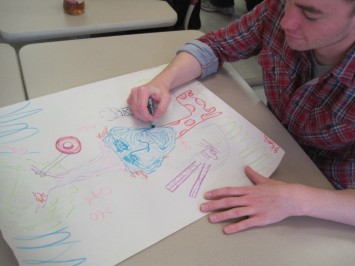
William (Bill) Koch, Biology Major, Ecophilosophy, Ursuline College, Spring 2012, from an ungraded, written class reflection:
I really enjoyed the life system drawings that we did. After the professor explained the function and commonalities of the project, I had fun interpreting and evaluating my own perspective. Like many others I had drawn myself in the center, yet I had both a human and giraffe body. I feel that this represented my interpretation of how everything in nature is connected as well as how we as humans are animals too. Also, it was interesting how I chose an animal that is tall, subconsciously illustrating how humans see themselves above or even apart from nature. This idea of height traveled into my second class activity when the class went out into the campus woods. When we pieced together nature monuments, I again subconsciously chose tall branches and pieces of wood. Maybe I still have more human-nature barriers to overcome.
Bethany Baughman, Art Student, Ecophilosophy, Ursuline College, Spring 2012, from an ungraded, written class reflection:
As an artist, I really enjoyed the projects we worked on in class. Creating my own system through imagery was a fun way to organize how I view myself in the world. Going into art therapy, I may just have to use this project…
Douglas Bitner, Nursing Student, Ecophilosophy, Ursuline College, Spring 2012, from an ungraded, written class reflection:
The instructor also gave us opportunities to examine ourselves and what we valued in our lives by creating a self system…we created a drawing that represented the systems in our lives and how we were interconnected. This gave us a chance to see and introduce ourselves to our classmates in a manner that was relevant to our lives.
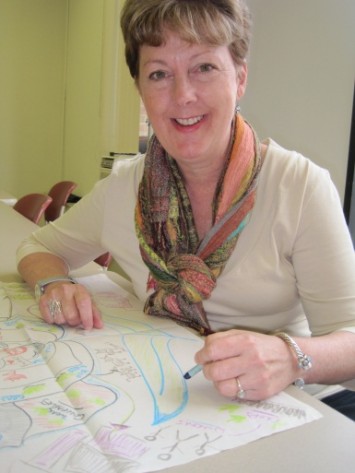
Linda Alexander, Masters in Liberal Studies, Ecophilosophy, Ursuline College, Spring Semester, 2012. From an email exchange with Linda:
The self system drawings were interesting on a few levels (listening to the various interpretations of my classmates and, of course, my own drawing in comparison). Given we were presented with this exercise at the front end of the class, we were all coming from a fairly authentic place in terms of how we interpreted our environment and our own place within it. While I focused on my family, relatives, friends, local community and also the natural world we depend upon, my drawing has a more linear feel than a dynamic process of interactivity. I recall being more the center of the universe (my home), but not the reality of life. Given time to reflect and additional education, my next drawing would be less ego-centric and more dynamic or interactive–attempting to encompass just about everything. I am not sure how I would actually draw that!
References:
Bateson, Gregory. 1979/2002 Mind and nature: A necessary unity. Cresskill, NJ: Hampton Press.
———. 1972/2000. Steps to an ecology of mind. Chicago, IL: University of Chicago Press.
Berry, Thomas. 2009. ed. Mary Evelyn Tucker, The Sacred Universe: Earth, Spirituality, and Religion in the Twenty-First Century, New York: Columbia University Press.
Berman, Morris. 1981. The reenchantment of the world. Ithaca, NY: Cornell University Press.
Brenner, Nurete. 2010. The Field Beyond Wrongdoing and Rightdoing: A Study of Arab-Jewish Grassroots Dialogue Groups in the United States. PhD diss., Case Western Reserve University. Cleveland, OH. Unpublished.
Emerson, Ralph Waldo. 1936/1949. Nature. Boston and Cambridge: James Munroe and Company.
Macy, Joanna. 1983. Despair and personal power in the Nuclear Age. Gabriola Island, British Columbia, Canada: New Society.
———. 1991a. Mutual causality in Buddhism and general systems theory: The dharma of living systems. Albany, NY: SUNY Press.
———. 1991b. World as lover, world as self. Berkeley: Parallax Press.
———. 1998. Coming back to life: Practices to reconnect our lives, our world. With Molly Young Brown. Gabriola Island, Canada: New Society.
Macy, Joanna. John Seed and Pat Fleming. 1988/2007. Thinking Like a Mountain: Towards A Council of All Beings. Gabriola Island, BC: New Society Publishers.
Meacham, Elizabeth. 2011. Emerson, Macy, and the Evolution of Participatory Epistemology.
PhD diss., California Institute of Integral Studies. Ann Arbor, MI: UMI Dissertation Publishing (UMI 3457731).
Merleau-Ponty, Maurice. 1945/1962. Phenomenology of perception. London: Routledge & Paul.
Skolimowski, Henryk. 1994. The participatory mind. New York, NY: Arcana/Penguin Books.
Varela, Francisco, Evan Thompson, and Eleanor Rosch. 1991. The embodied mind: Cognitive science and human experience. Cambridge, MA: MIT Press.







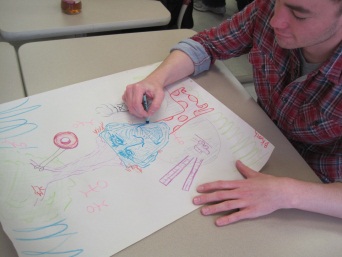
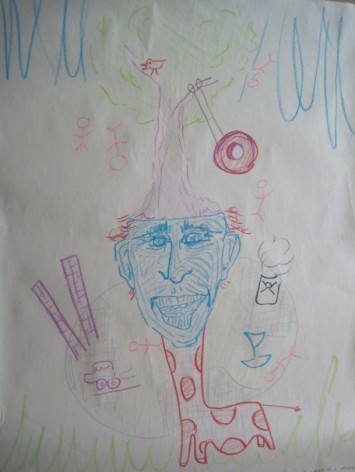
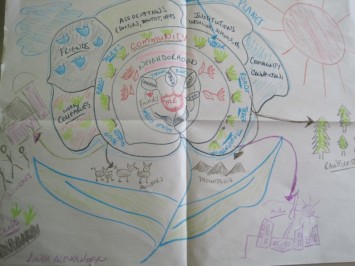



 Elizabeth E. Meacham, PhD, is an Assistant Professor of Philosophy and Religious Studies at Ursuline College in Pepper Pike, OH. She created and directs the Online Graduate Certificate in Sustainability and Spirituality and teaches courses in environmental philosophy, ecojustice, bioethics, ecopsychology, and sustainability.
Elizabeth E. Meacham, PhD, is an Assistant Professor of Philosophy and Religious Studies at Ursuline College in Pepper Pike, OH. She created and directs the Online Graduate Certificate in Sustainability and Spirituality and teaches courses in environmental philosophy, ecojustice, bioethics, ecopsychology, and sustainability. 
